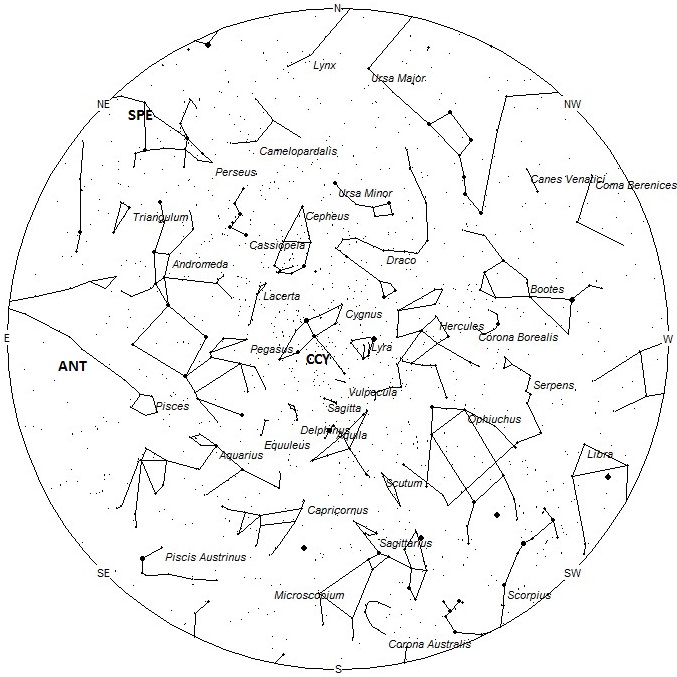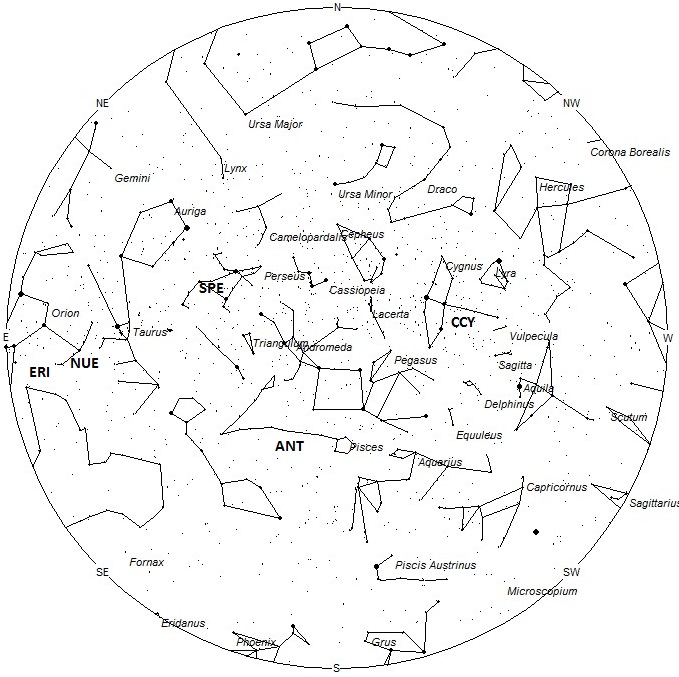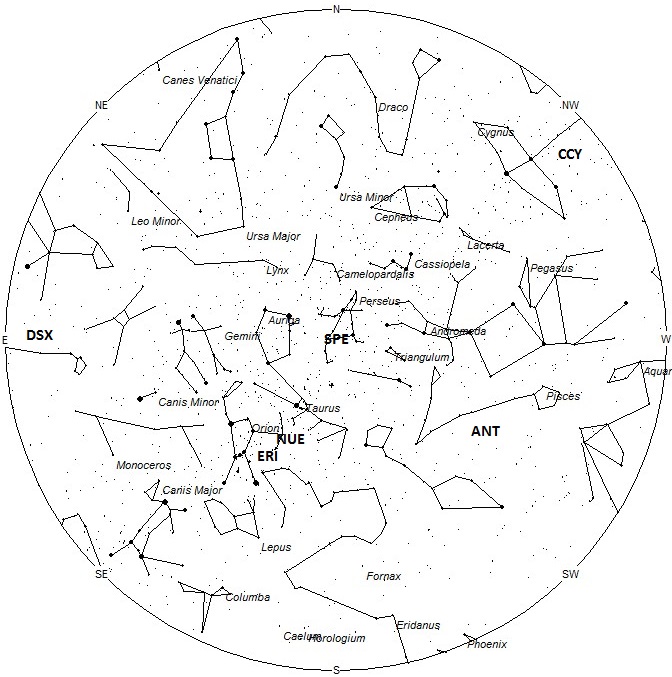
Credit & Copyright: Derek Demeter (Emil Buehler Planetarium
During this period the moon will reach its first quarter phase on Sunday September 16th. At that time the moon will lie 90 degrees east of the sun and will set near midnight local daylight saving time (LDT). As the week progresses the waxing gibbous moon will set later and later, shrinking the window of opportunity to view meteor activity under dark skies. The estimated total hourly meteor rates for evening observers this week is near 3 as seen from mid-northern latitudes and also 2 for those viewing from subtropical southern latitudes (25S). For morning observers the estimated total hourly rates should be near 14 for those viewing from mid-northern latitudes and 10 for those viewing from subtropical southern latitudes (25S). The actual rates will also depend on factors such as personal light and motion perception, local weather conditions, alertness and experience in watching meteor activity. Evening rates are reduced during this period due to moonlight. Note that the hourly rates listed below are estimates as viewed from dark sky sites away from urban light sources. Observers viewing from urban areas will see less activity as only the brighter meteors will be visible from such locations.
The radiant (the area of the sky where meteors appear to shoot from) positions and rates listed below are exact for Saturday night/Sunday morning September 15/16. These positions do not change greatly day to day so the listed coordinates may be used during this entire period. Most star atlases (available at science stores and planetariums) will provide maps with grid lines of the celestial coordinates so that you may find out exactly where these positions are located in the sky. A planisphere or computer planetarium program is also useful in showing the sky at any time of night on any date of the year. Activity from each radiant is best seen when it is positioned highest in the sky, either due north or south along the meridian, depending on your latitude. It must be remembered that meteor activity is rarely seen at the radiant position. Rather they shoot outwards from the radiant so it is best to center your field of view so that the radiant lies near the edge and not the center. Viewing there will allow you to easily trace the path of each meteor back to the radiant (if it is a shower member) or in another direction if it is a sporadic. Meteor activity is not seen from radiants that are located far below the horizon. The positions below are listed in a west to east manner in order of right ascension (celestial longitude). The positions listed first are located further west therefore are accessible earlier in the night while those listed further down the list rise later in the night.
These sources of meteoric activity are expected to be active this week.
The last of the chi Cygnids (CCY) are expected this weekend. The radiant currently lies at 20:12 (303) +32 which places it in central Cygnus, 2 degrees west of the faint star known as 39 Cygni. Rates are expected to be less than 1 per hour no matter your location. This radiant is best near 22:00 (10pm LDT) when it lies highest in the sky. With an entry velocity of 15 km/sec., the average chi Cygnid meteor would be very slow.
The center of the large Anthelion (ANT) radiant is currently located at 00:28 (007) +03. This position lies in southern Pisces, 5 degrees southwest of the 4th magnitude star known as delta Piscium. Due to the large size of this radiant, Anthelion activity may also appear from northwestern Cetus as well as Pisces. This radiant is best placed near 0200 LDT, when it lies on the meridian and is located highest in the sky. Hourly rates at this time should be near 2 no matter your location. With an entry velocity of 30 km/sec., the average Anthelion meteor would be of medium-slow velocity.
The September Epsilon Perseids (SPE) are active from September 3 through October 3 with the peak occurring on the night of September 10/11. The radiant is currently located at 03:40 (055) +40. This position lies just 3 degrees west of the 3td magnitude star known as epsilon Persei. The radiant is best placed near 0500 LDT, when it lies highest above the horizon. Rates are expected to be near 1 per hour as seen from the northern hemisphere and less than 1 as seen from the southern hemisphere. With an entry velocity of 65 km/sec., most activity from this radiant would be swift.
The nu Eridanids (NUE) were co-discovered by Japanese observers using SonotoCo and Juergen Rendtel and Sirko Molau of the IMO. Activity from this long-period stream stretches from August 24 all the way to November 16. Maximum activity occurs on September 24th. The radiant currently lies at 04:38 (070) +05, which places it in southeastern Taurus, 3 degrees southwest of the 3rd magnitude star known as Tabit (pi 3 Orionis). This area of the sky is best seen during the last dark hour before dawn when the radiant lies highest in a dark sky. Current rates are expected to be near 1 per hour during this period no matter your location. With an entry velocity of 67 km/sec., the average meteor from this source would be of swift velocity.
The last of the eta Eridanids (ERI) are expected this weekend from a radiant located at 05:00 (075) -02, which places it in northeastern Eridanus, 4 degrees south of the 4th magnitude star known as pi 6 Orionis. This area of the sky is best seen during the last dark hour before dawn when the radiant lies highest in a dark sky. Current rates are expected to be less than 1 per hour during this period no matter your location. With an entry velocity of 65 km/sec., the average meteor from this source would be of swift velocity.
The Daytime Sextantids (DSX) are not well known due to the fact that the radiant lies close to the sun and these meteors are only visible during the last couple of hours before dawn. The radiant is currently located at 09:29 (142) +03. This position lies in western Hydra, 3 degrees northeast of the 4th magnitude star known as theta Hydrae. This area of the sky is best placed in the sky during the last hour before dawn, when it lies highest above the horizon in a dark sky. Since the maximum is not until September 29th, current rates would be most likely less than 1 per hour no matter your location. Spotting any of this activity would be a notable accomplishment. With an entry velocity of 33km/sec., most activity from this radiant would be of medium-slow speed.
As seen from the mid-northern hemisphere (45N) one would expect to see approximately 10 sporadic meteors per hour during the last hour before dawn as seen from rural observing sites. Evening rates would be near 2 per hour. As seen from the tropical southern latitudes (25S), morning rates would be near 7 per hour as seen from rural observing sites and 1 per hour during the evening hours. Locations between these two extremes would see activity between the listed figures. Evening rates are reduced during this period due to moonlight.
The list below offers the information from above in tabular form. Rates and positions are exact for Saturday night/Sunday morning except where noted in the shower descriptions.
| SHOWER | DATE OF MAXIMUM ACTIVITY | CELESTIAL POSITION | ENTRY VELOCITY | CULMINATION | HOURLY RATE | CLASS |
| RA (RA in Deg.) DEC | Km/Sec | Local Daylight Saving Time | North-South | |||
| chi Cygnids (CCY) | Sept 13-14 | 20:12 (303) +32 | 15 | 22:00 | <1 – <1 | IV |
| Anthelions (ANT) | – | 00:28 (007) +03 | 30 | 02:00 | 2 – 2 | II |
| September Epsilon Perseids (SPE) | Sep 10 | 03:40 (055) +40 | 65 | 06:00 | 1 – <1 | II |
| nu Eridanids (NUE) | Sep 24 | 04:38 (070) +05 | 67 | 07:00 | 1 – 1 | IV |
| eta Eridanids (ERI) | Aug 11 | 05:00 (075) -02 | 65 | 08:00 | <1 – <1 | IV |
| Daytime Sextantids (DSX) | Sep 29 | 09:29 (142) +03 | 33 | 12:00 | <1 – <1 | IV |
 American Meteor Society
American Meteor Society



I saw something this morning over Memphis Tn. Unbelievable! So fast and bright. it looked like it must have been big when it burned. It was white and the streak was triangular like streak that had a green colored out line. It was moving down but so fast it was a lot faster than lightning. I love this stuff but not real science. If there was a tracked event between 3:00am and 4:00 am north of Memphis Tn, I would love to know. Anyone with know how and data whiling to tell Me?! Or where i can look?
Im in Central Florida, I definitely just saw some activity in the Southeastern Skies, 5:55am approx, I can not find any verification, though, I definitely witnessed it as it broke through into lower atmosphere. Did you see it?? Please advise.
Saw something amazing in the sky in South Florida around 11:45 PM September 21st, Friday Evening. I have never seen anything like it so I went on a google search and found this page. Not sure what it was, way more light trailing than any meteor I have seen, was visible for about 2.5 seconds.
Was on my way home last night one came down right in front of us. My husband is a biologist so it was for real count believe it. Twiggs Co ga
Saw one tonight, caught a rough pic against the moonlight. Trail lead east to west across Green Bay